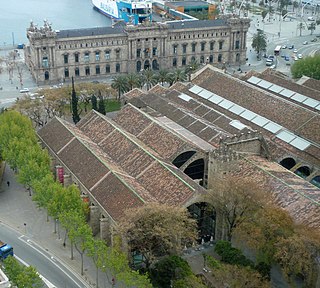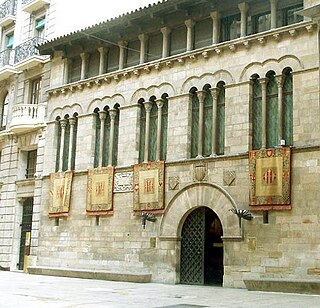
The Gothic Quarter is the centre of the old city of Barcelona. It stretches from La Rambla to Via Laietana, and from the Mediterranean seafront to the Ronda de Sant Pere. It is a part of Ciutat Vella district.

The Palau de la Generalitat de Catalunya is a historic palace in Barcelona, Catalonia. It houses the offices of the Presidency of the Generalitat de Catalunya. It is one of the few buildings of medieval origin in Europe that still functions as a seat of government and houses the institution that originally built it.

Calaf is the main town in the northern portion of the comarca of the Anoia in Catalonia, Spain, situated on the Calaf Plain. The town holds an important weekly livestock market.

Bassella is a municipality in the comarca of the Alt Urgell, in Catalonia, Spain. The village of Bassella, one of nine settlement which make up the municipality, is located at the confluence of the Segre river with the Salada river and at the point where the route from Solsona and the potash mines of Cardona meets the route between Lleida and La Seu d'Urgell. The ajuntament is located in Castellnou de Bassella.

Fígols i Alinyà is a municipality in the comarca of the Alt Urgell in Catalonia, Spain. It is situated on the left bank of the Segre river between Coll de Nargó and Organyà, just above the Oliana reservoir. The municipality was formed in 1972 by the merger of the municipalities of Fígols d'Organyà and Alinyà: the ajuntament is in Fígols. A local road links the municipality with Organyà.

Barcelona'sculture stems from the city's 2000 years of history. To a greater extent than the rest of Catalonia, where Catalonia's native Catalan is more dominant, Barcelona is a bilingual city: Catalan and Spanish are both official languages and widely spoken. Since the arrival of democracy, the Catalan culture has been promoted, both by recovering works from the past and by stimulating the creation of new works.

The Roca dels Moros or Caves of El Cogul is a rock shelter containing paintings of prehistoric Levantine rock art. The site is in El Cogul, in the autonomous community of Catalonia, Spain. Since 1998 the paintings have been protected as part of the Rock art of the Iberian Mediterranean Basin, a UNESCO World Heritage Site. Inscriptions in Northeastern Iberian script and in Latin alphabet indicate that the place was used as a sanctuary into Iberian and Roman times.

The Museum and Study Center of Sport Doctor Melcior Colet is a facility dedicated to the promotion and exhibition of the most prominent in the development of the history of the sport in Catalonia in recent centuries. It is based in an Art Nouveau house built in 1911 by Josep Puig i Cadafalch the Casa Pere Company, which is located in Buenos Aires street, 56, Barcelona.

Lleida Museum, officially the Diocesan and Comarcal Lleida Museum, is an art and history museum located in Lleida, Catalonia, Spain.

La Morera de Montsant is a village in the province of Tarragona and autonomous community of Catalonia, Spain.

The Can Tinturé Museum, in Esplugues de Llobregat, is located in a house built at the end of the 19th century by architect Claudi Duran i Ventosa, and is the first monographic sample tile museum in Spain. The Can Tinturé Museum also manages the museum at the Pujol i Bausis factory, La Rajoleta, which was a point of reference in the production of Catalan industrial tiles, especially during the highpoint of Art Nouveau. The Museum is part of the Barcelona Provincial Council Local Museum Network and of the territorial system of the Science and Technology Museum of Catalonia.

The L’Hospitalet Museum, in L'Hospitalet de Llobregat (Barcelonès), is a municipally owned cultural facility that aims to disseminate and conserve the cultural heritage and resources of L'Hospitalet. The museum was opened in 1972 in Casa Espanya, built in the 16th century, and is part of the Barcelona Provincial Council Local Museum Network.

The Mataró Museum is a museum in Mataró, in El Maresme, with a central office in Can Serra, a fortified Renaissance building dating back to 1565. The Museum, which is part of the Barcelona Provincial Council Local Museum Network, also manages the different local heritage centres, such as:
The Vilassar de Mar Municipal Museum is a local museum in Vilassar de Mar comprising two facilities: The Marina Museum, focusing on local history and placing special emphasis on its connection with the nautical world, and the Monjo Museum, which tells the story behind the legacy of Vilassar de Mar sculptor Enric Monjo.

Antoni Abad i Roses is a Spanish artist. He began his career as a sculptor, and evolved over time towards video art and later in net.art and other forms of new media.

Jaume Morera i Galícia was a Catalan landscape painter.

The Maritime Museum of Barcelona (MMB) is located in the building of Drassanes Reials de Barcelona , the royal arsenal of Barcelona, dedicated to shipbuilding between the thirteenth century and eighteenth century. The first mention of these arsenals date from 1243 in a document indicating the boundaries of the city of Barcelona where it mentions its shipyard.

The following outline is provided as an overview of and topical guide to Barcelona:





















